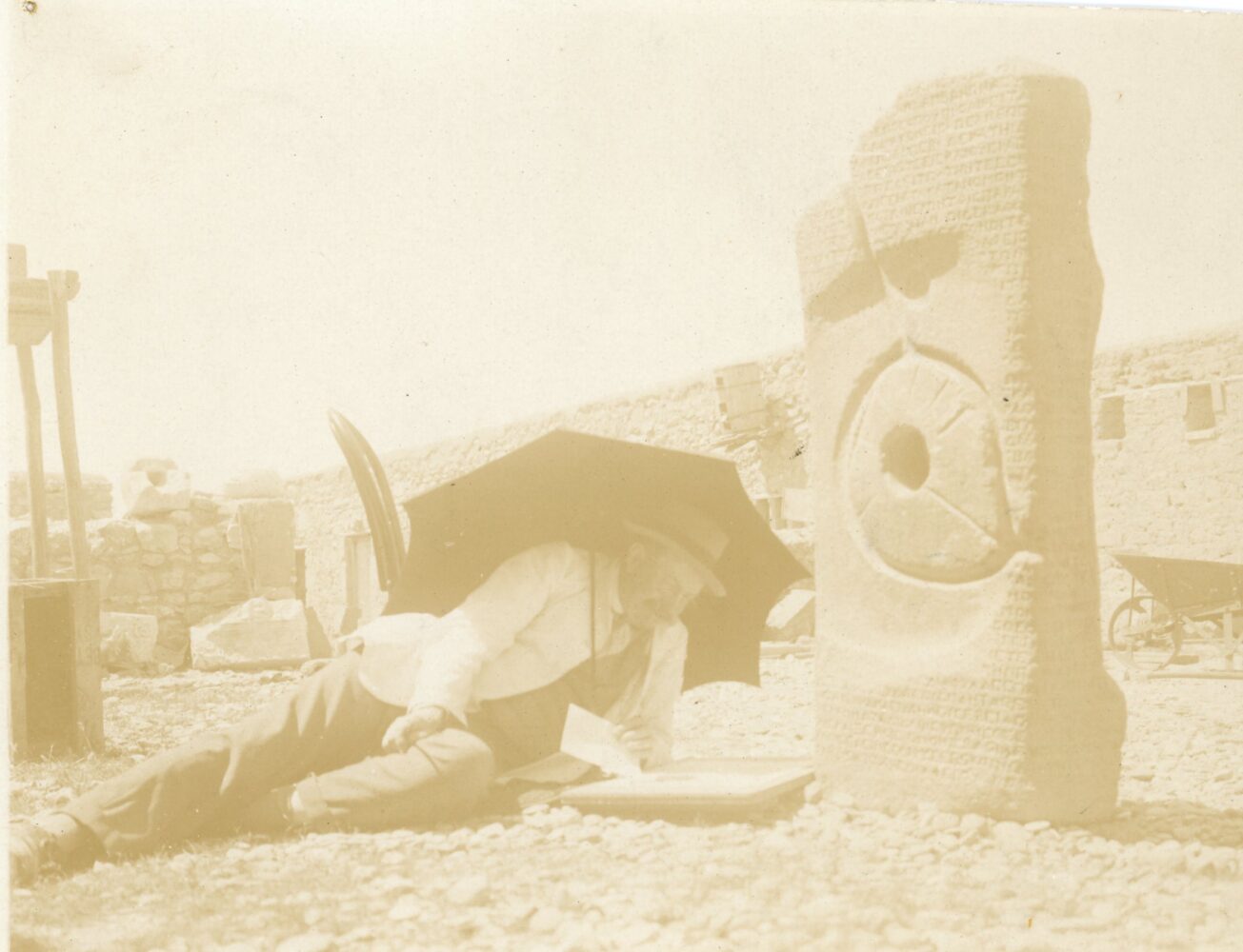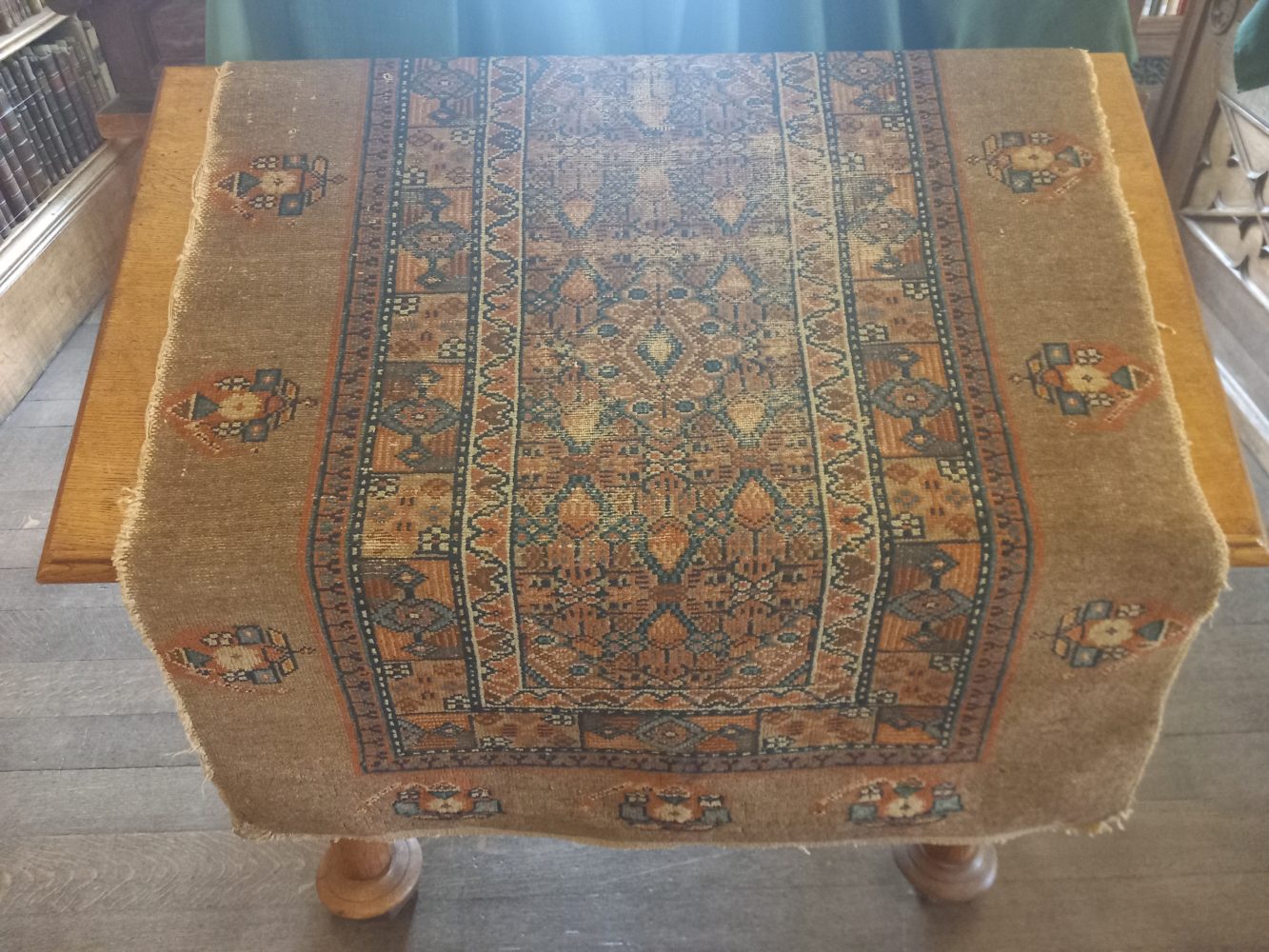![Letter from T.E. Lawrence to D.G. Hogarth, 16 Dec [?], page 1. Hogarth Papers, P452/REL/2/1](https://lawrenceinfragments.magd.ox.ac.uk/wp-content/uploads/2023/08/2-Archaeology-P452_REL_2_1-TEL-to-DGH-16-Dec-1-1-scaled-e1692369093891-627x1024.jpg)


From 1910 to 1914, T.E. Lawrence worked as an archaeologist on the British Museum’s dig at Carchemish (also known as Karkamish), an ancient Hittite city on the banks of the Euphrates, on the border of modern-day Turkey and Syria. His work there was arranged under the auspices of Magdalen College through David George Hogarth (1862–1927), Fellow of Magdalen and Keeper of the Ashmolean Museum. During that period Lawrence also first met Gertrude Bell (1868–1926), the famed archaeologist and traveller.
Magdalen recently acquired the papers of David Hogarth, which include a collection of letters sent by Lawrence to Hogarth from 1911 to Hogarth’s death in 1927. The collection also includes letters from Gertrude Bell to Hogarth. In both sets of letters, detailed archaeological work mingles with exploration of the country, discussion of the political situations the writers find themselves in, and post-war comments on the writers’ somewhat troubled mental states.
A Most Glorious Night
Letter from T.E. Lawrence to D.G. Hogarth c. 1911-1913, describing his return to the Carchemish site, which was located close to the place German engineers were building a bridge over the Euphrates for the Berlin-Baghdad railway at Jerablus. Lawrence reports that the Germans “broke up with a yell, and rushed down the path to meet me.” He and Haj Wahid “put up with the Hoja, and had a most glorious night” in which they “heard all about the Germans: they put on airs.”
Hogarth Papers, P452/REL/2/1
![Letter from T.E. Lawrence to D.G. Hogarth, 16 Dec [?], page 1. Hogarth Papers, P452/REL/2/1](https://lawrenceinfragments.magd.ox.ac.uk/wp-content/uploads/2023/08/2-Archaeology-P452_REL_2_1-TEL-to-DGH-16-Dec-1-1-scaled-e1692369093891-627x1024.jpg)
![Letter from T.E. Lawrence to D.G. Hogarth, 16 Dec [?], page 1. Hogarth Papers, P452/REL/2/1](https://lawrenceinfragments.magd.ox.ac.uk/wp-content/uploads/2023/08/2-Archaeology-P452_REL_2_1-TEL-to-DGH-16-Dec-1-1-scaled-e1692369093891-627x1024.jpg)
![Letter from T.E. Lawrence to D.G. Hogarth, 16 Dec [?], page 2-3. Hogarth Papers, P452/REL/2/1](https://lawrenceinfragments.magd.ox.ac.uk/wp-content/uploads/2023/08/2-Archaeology-P452_REL_2_1-TEL-to-DGH-16-Dec-2-1-scaled-e1692182362873-1024x828.jpg)
![Letter from T.E. Lawrence to D.G. Hogarth, 16 Dec [?], page 4. Hogarth Papers, P452/REL/2/1](https://lawrenceinfragments.magd.ox.ac.uk/wp-content/uploads/2023/08/2-Archaeology-P452_REL_2_1-TEL-to-DGH-16-Dec-3-1-scaled-e1692182468555-631x1024.jpg)
Excavating the Mound at Carchemish
Letter from T.E. Lawrence to D.G. Hogarth, 1911, describing the process of excavating the mound at Carchemish in typically idiosyncratic fashion. Lawrence describes finding “two pre-historic walls, a lot of pot burials, and a splendid place to camp”. He then decides to actually camp in the dig itself, writing “I am pitching a bed & a tent in the best room of the commodious prehistoric villa-residence uncovered” and that he “built a beautiful wall round the lip of the pit, for fear lest asses should invade my bed-room”. He then goes on to explain the finds in the dig in detail, including a pedestal which “sits on the back of two lions”.
Hogarth Papers, P452/REL/2/1




D.G. Hogarth
Photograph of David Hogarth at an archaeological site, possibly Carchemish.
Hogarth Papers, P452/PER/3/2


Keeper of the Ashmolean
In this note from 1908, Hogarth thanks the Arabist Charles Doughty (1843–1926) for his congratulations after Hogarth was appointed Keeper of the Ashmolean Museum, a post previously held by the eminent archaeologist Sir Arthur Evans (1851–1941).
On the reverse, he comments on the planned removal of antiquities to Britain, lamenting that “My Syrian discoveries are, alas! Still locked up by pending negotiations with Turkey.”
Hogarth Papers, P452/ACA/3/1



A Tour of Carchemish
In this letter, Gertrude Bell asks Hogarth to show the site at Carchemish to her “German friends”, including Dr Ernst Emil Herzfeld, an archaeologist who was then working at a site at Samarra. Bell asks Hogarth if Herzfeld can “see the things locked up in your little museum there.”
Hogarth Papers, P452/REL/1
![Letter from Gertrude Bell to D.G. Hogarth, 1 Oct [?], page 2-3. Hogarth Papers, P452/REL/1](https://lawrenceinfragments.magd.ox.ac.uk/wp-content/uploads/2023/08/9-Archaeology-P452-_REL_1-German-friends-letter-1-scaled-e1692183641742-653x1024.jpg)
![Letter from Gertrude Bell to D.G. Hogarth, 1 Oct [?], page 2-3. Hogarth Papers, P452/REL/1](https://lawrenceinfragments.magd.ox.ac.uk/wp-content/uploads/2023/08/9-Archaeology-P452-_REL_1-German-friends-letter-1-scaled-e1692183641742-653x1024.jpg)
![Letter from Gertrude Bell to D.G. Hogarth, 1 Oct [?], page 2-3. Hogarth Papers, P452/REL/1](https://lawrenceinfragments.magd.ox.ac.uk/wp-content/uploads/2023/08/9-Archaeology-P452-_REL_1-German-friends-letter-2-1-scaled-e1692183584515-1024x813.jpg)
![Letter from Gertrude Bell to D.G. Hogarth, 1 Oct [?], page 4. Hogarth Papers, P452/REL/1](https://lawrenceinfragments.magd.ox.ac.uk/wp-content/uploads/2023/08/9-Archaeology-P452-_REL_1-German-friends-letter-3-1-scaled-e1692183722679-658x1024.jpg)
Rebellion at Najaf
During the First World War, Bell and Hogarth were both part of the Arab Bureau – the British intelligence group based in Cairo that operated across the Arab world. Writing in January 1918 from Baghdad, where the British were attempting to gain control, Bell admits that recently “The Arab Bureau has been much neglected” and “I’ll amend my ways with regard to A.B. reports.”
Bell then reports on rebellion in Najaf, a city on the Euphrates, now in Iraq, in which a Sheikh called Haji ‘Atiyah abu Qulal “assembled a body of ruffians […], who fired at the cavalry and killed a trooper.” Bell is of the opinion that this “brought an impossible situation to a close”, adding “we shall now have no difficulty in taking hold there.” Two months later, further rebellion in the city would lead to the Siege of Najaf by the British.
Hogarth Papers, P452/REL/1




Concern for Lawrence
In this post-war letter, written in 1925 whilst Bell was recuperating from illness at her family home in North Yorkshire, Bell discusses Lawrence’s mental state with David Hogarth. Referring to Lawrence as “our sheep”, she writes that in her opinion “those who talk of their end are not apt to precipitate it.” However, encouraging Lawrence’s interest in writing Seven Pillars of Wisdom “is to postpone action in that direction. Life is very strong – it catches you again even when it has surely lost all chance to lay hold. If one reaches the moment when it definitely can’t, then that is the moment to let go.” Gertude Bell died the following year from a suspected overdose.
Hogarth Papers, P452/REL/1




Rug owned by Lawrence
This rug was brought back by T.E. Lawrence from Arabia.
Donation to Magdalen College by Nicolas Barker
